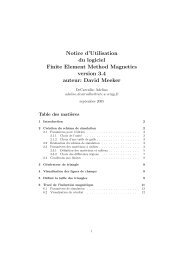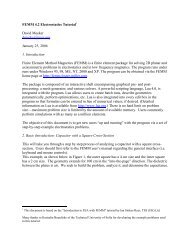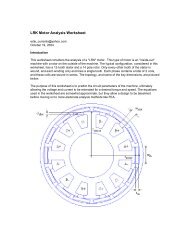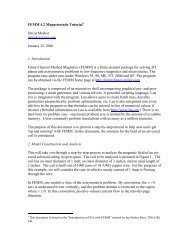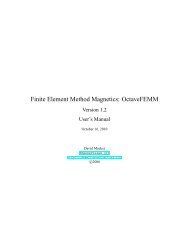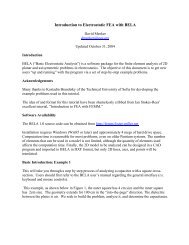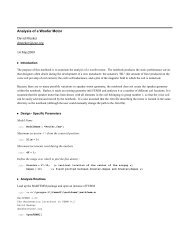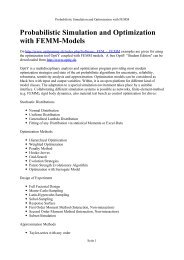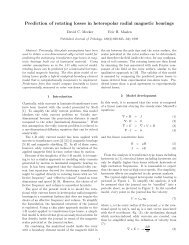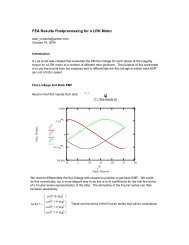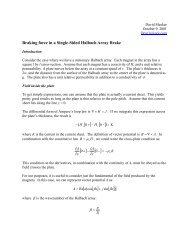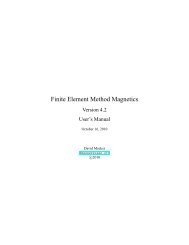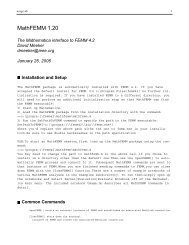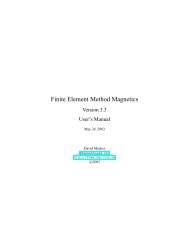1 Introduction - Finite Element Method Magnetics
1 Introduction - Finite Element Method Magnetics
1 Introduction - Finite Element Method Magnetics
Create successful ePaper yourself
Turn your PDF publications into a flip-book with our unique Google optimized e-Paper software.
• Lorentz torque (rxJxB) This selection computes the torque about (0,0) resulting from<br />
Lorentz forces.<br />
• Integral of B over block This integral can be useful in computing Lorentz forces. Since<br />
Lorentz force is J ×B, the force that would be produced if a coil were placed in a certain part<br />
of the solution domain can be inferred by integrating B, and then scaling times an arbitrarily<br />
chosen current density to get force.<br />
• Total current This integral returns the total specified currents in the given block.<br />
• Block Volume For axisymmetric problems, this selection returns the volume swept out by<br />
the selected block.<br />
• Force via Weighted Stress Tensor New in version 3.3, the Weighted Stress Tensor<br />
block integrals automatically compute a weighting function over the finite element mesh that<br />
allows all possible air elements to contribute to the stress tensor integration. This approach<br />
is essentially identical to the weighted stress tensor approach described in [5] and/or [6].<br />
To compute the force on a region or set of regions, the user selects the blocks upon which<br />
force result is desired and selects the Force via Weighted Stress Tensor integral. The<br />
program then computes the weighting function by solving an additional Laplace equation<br />
over the air surrounding the blocks upon which the force is to be computed. It may take a<br />
few seconds to compute the weighting function–progress is be indicated by a progress bar<br />
that is displayed while the weighting function is being computed. The stress tensor is then<br />
evaluated as a volume integration, and the results are displayed. The results are typically<br />
more accurate than the Maxwell Stress Tensor line integral, since in some sense, all possible<br />
contours have been averaged to yield the Weighted Stress Tensor force result.<br />
If the user is interested in the contours along which the integral was performed, the ”stress<br />
tensor mask” box can be checked in the contour plot dialog. A set of orange (by default)<br />
lines will be displayed that.<br />
• Torque via Weighted Stress Tensor This integral is torque version of the Force via<br />
Weighted Stress Tensor integral. Instead of force, torque about (0,0) is computed using<br />
the same weighting function approach.<br />
5.11 Force/Torque Calculation<br />
Ultimately, the estimation of magnetically produced forces and torques is often the goal of a finite<br />
element analysis. This section discusses some of the different methods of deducing forces and<br />
torques using FEMM.<br />
5.11.1 Lorentz Force/Torque<br />
If one is attempting to compute the force on a collection of currents in a region containing only<br />
materials with a unit relative permeability, the volume integral of Lorentz torque is always the<br />
method to employ. Lorentz force results tend to be very accurate. However, again, they are only<br />
applicable for the forces on conductors of with unit permeability (e.g. coils in a voice coil actuator).<br />
38



